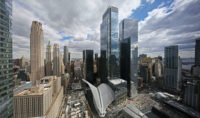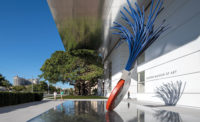Depending upon visitors’ angle of approach, Washington, D.C.’s new Spy Museum either announces its presence boldly or hides behind an unassuming party wall, which more or less sums up the guiding principles around its design by Rogers Stirk Harbour + Partners (RSH+P): being hidden, or hiding in plain sight. For those arriving by car or on foot, the Museum’s angled, red steel supports reach out in an informal wave; arrival by Metro means ascending a lengthy staircase from underground to arrive at the building’s aluminum-clad posterior.
The Spy Museum is a private institution that seeks to uncover some of the more covert aspects of spy craft as well as those that are less clandestine. Those two ideas, of concealment and (at least partial) revelation, play out in the programming of the 120,000-square-foot building. From a bright, day-lit, double-height lobby, visitors ascend to the nominal fifth floor, which begins the dual-level tour through the museum’s collection within windowless, black box-styled galleries (the third floor will eventually house traveling exhibitions). The floors above are dedicated to offices and events, and topped by a roof terrace that commands sweeping, relatively unobstructed, panoramic views—thanks to the building height being measured from the L’Enfant Plaza surface level.
RSH+P has plenty of structural ingenuity under its belt, and nowhere is this more apparent than in a dramatic stairway that connects those gallery boxes. Supported by chartreuse horizontal steel beams, the staircase hangs on stainless rods from sloping red double-L beams, which also absorb the glass curtainwall’s wind load. These structural gymnastics allow the building to reach out over the sidewalk while resolving the cantilever’s load into a single row of columns behind the property line—and are the result of highly specific limitations on where structure could land, based on everything already below the surface at L’Enfant Plaza.
“Imagine you're holding a beehive,” says Bryan Chun, who led the architect-of-record team from Hickok Cole Architects, which was involved in redevelopment talks with JBG a decade prior to RSH+P’s involvement. “Your job is to poke a needle through it two dozen times without upsetting the hornets. You know it's impossible. But that's the job.”
The plaza, master planned by I.M. Pei and Partners, features two buildings each by Araldo Cossutta and Vlastimil Koubek, sitting adjacent to Marcel Breuer’s HUD headquarters and atop Harry Weese’s concrete-vaulted Metro interchange station. Yet for all of that promise—and multiple efforts at improving pedestrian experience—L’Enfant Plaza has been decried in more recent years as less of a Brutalist beauty than 20 acres of barren concrete wasteland: a place that empties out promptly at five on Friday evenings, not to be revisited until eight on Monday mornings. There seems to be an undue amount of pressure on the Spy Museum to right urban renewal wrongs of L’Enfant Plaza.
“It's gone from Plaza to piazza—from big scale to human scale,” design architect and RSH+P principal Ivan Harbour says. He explains the concept behind the building’s inclined form over the stairway as “leaning to support the hanging, diaphanous facade in front of that piece of virtual public realm.”
The scalar shift stems from proposed infill within the over-sized plaza, schemes for which RSH+P explored with developer JBG in 2015. And human-scaled enlivening is something this part of Washington, D.C., could certainly use. L’Enfant Plaza, which was once the proving ground for the city’s urban renewal, never realized its planned potential, despite the pedigree of its architecture.
Now, the Spy Museum is part of two revitalization efforts: one for Tenth Street (also known as L’Enfant Promenade), and the other for a proposed Southwest Eco-District. Tenth Street as it currently exists is a bridge between the Department of Energy Forrestal Building at its northern end, and a fountain named after African-American polymath Benjamin Banneker at its southern end, crossing over sub-grade parking and loading decks as well as the Interstate 395 highway. With the addition of The Wharf, a $2.5 billion redevelopment of the District’s southwest waterfront, the Spy Museum becomes a midway anchor to draw visitors southward from the Mall.
In between the two exhibition gallery levels of the new Spy Museum, which opened to the public on May 12, there’s a circulation moment that could serve as a larger metaphor for the building itself: Tucked behind black screens that obscure outward views, a bright green staircase descends from the fifth floor to the fourth, with just enough light to suggest the outdoors without actually seeing it. This single-story stair is just an amuse-bouche for the multi-level extravaganza that brings visitors from the galleries back down to the ground floor, enlivening the facade with their movement.
“People moving around down through the veil, and down through these suspended strata, become kind of part of this intrigue to the outside,” says project architect John McElgunn. “We're surrounded by the Pei master plan of kind of beautiful Brutalist buildings, but they don't offer a huge amount back. And as you walk down the street, you see what's going on there in splashes of color of people moving through the facade.”
What remains to be seen is how the Spy Museum will fare in a city replete with competing—and free—institutions along a corridor that receives some 30 million annual visitors. The Spy Museum waves a code flag toward the National Mall, but can anyone there decipher it?







Post a comment to this article
Report Abusive Comment